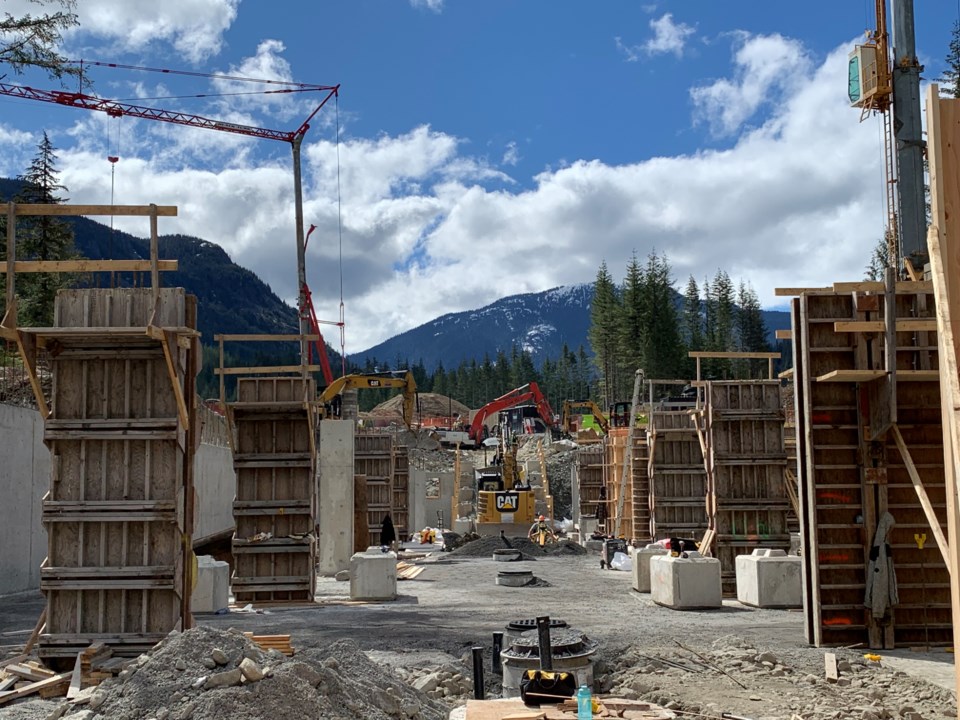The Resort Municipality of Whistler (RMOW) is banking on a national housing fund to ramp up the development of new units and put a “major dent” in the resort’s longstanding housing shortage.
At the regular meeting of council on Tuesday, Aug. 1, elected officials greenlit a recommendation from municipal staff to submit a grant application to the Canada Mortgage and Housing Corporation’s (CMHC) Housing Accelerator Fund, a multibillion-dollar national program announced last year, with a target of helping local governments permit 100,000 new housing units across the country over a three-year period.
“This is great work, and I am hopeful this would make a major dent in our No. 1 priority at this table,” said Mayor Jack Crompton following a staff presentation to council.
Designed to empower local governments in land-use planning and development approvals, the Housing Accelerator Fund (HAF) provides incentive funding to increase housing supply and “support the development of complete, low-carbon and climate-resilient communities that are affordable, inclusive, equitable and diverse,” according to the CMHC.
Local governments across the country—including in both Pemberton and Squamish—are vying for a piece of the $4-billion fund, which comes with stringent eligibility criteria. Successful applicants must, for instance, commit to a minimum 10-per-cent annual increase in housing growth rate, and boost housing supply by no less than 1.1 per cent a year in that span.
Taking that metric, over the past 10 years, the RMOW has averaged 80 net new housing units a year, a 0.78-per-cent growth rate. Achieving the minimum 1.1-per-cent growth rate would require an average of 113 net new units a year, a growth rate of 41 per cent.
Given the initiatives the municipality has set out as part of its application, “we are confident that we can meet the minimum requirements and growth targets required by the grantor,” said RMOW planning policy analyst Claire Van Leeuwen in Tuesday’s presentation.
Eligible applicants must outline at least seven initiatives that will grow housing supply and expedite housing approvals, and, if successful, the initiatives must be completed within the first two years of the program. Local governments must also provide for long-term efficiencies designed to increase housing inventory and enhance certainty in the building and approval process.
The RMOW has identified eight initiatives that staff thinks will offer the best chance at scoring high in the evaluation criteria, the majority of which dovetail with the commitments already included in the municipality’s Housing Action Plan, unveiled in May: Establish a workforce housing funding and financing strategy; develop a new infill housing program; initiate pre-zoning of targeted sites to incentivize workforce housing: establish an auxiliary residential dwelling unit catalyst program; implement electronic permitting at municipal hall; establish phased development plans to advance workforce housing on municipal lands; monitor and identify workforce shortfall and long-term housing needs; and complete a vulnerable populations housing needs assessment.
“Because we already had our Housing Action Plan in place, we were able to fill out an application in a super informed way,” said municipal CAO Ginny Cullen following Tuesday’s meeting.
Improving Whistler’s sluggish building permit process should be music to the ears of local developers, who were critical of the RMOW’s meticulous approval criteria and long wait times even before a pandemic-fuelled backlog and staffing shortage hit municipal hall. There are currently 164 permits in process at the building department, and staff is now reviewing single-family and duplex residential applications from April, and multi-family and commercial applications from February.
Digitizing the permit process, something the RMOW already intended on doing prior to applying to the HAF, is but one factor that would speed up approvals, added Cullen.
“The No. 1 thing isn’t necessarily a digital application. It’s getting complete applications from the beginning and our ability to staff plan checkers,” she said, noting the RMOW is now looking to fill three plan checker positions. “Those two things are the most important in terms of being able to reduce those times.”
The national accelerator fund incentivizes housing through three cumulative components: base funding of approximately $20,000 per new unit; top-up funding for multi-unit housing of up to $15,000 per unit; and an affordable housing bonus of approximately $19,000 per unit. If the minimum targets are met, municipal staff estimates the RMOW could stand to receive at least $3.2 million through the fund. That’s before tacking on a possible affordable housing bonus, which RMOW staff has not yet calculated, as it is still determining what exactly would constitute “affordable” in Whistler’s distinct housing market.
“Having worked with CMHC and BC Housing a little bit, our market is an anomaly, and we don’t fit into their affordable box,” said Councillor Cathy Jewett. “So, I’d be really curious to see what model we use for that.”
The RMOW has until Aug. 18 to submit its application. Learn more at cmhc-schl.gc.ca.




